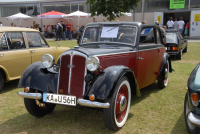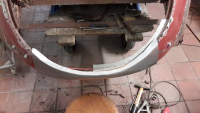Bodywork on the 1938 DKW
DKW is one of the forerunners of the modern Audi automobiles in conjunction with the Wanderer project described in one of my recent articles. The four rings of the Audi logo comes from the Auto Union. The modern (post WW2) Trabants and Wartburg autos,
from east european countries (before the fall of the Berlin wall), all har basically the same engine as this DKW. The engine is a 3 cylinder 2 stroke engine, and is actually designed by a Danish ingineer who's name was Joergen Skafte Rasmussen
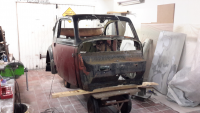
 This car has been sitting outside, in the scandinavian climate, under a tarpaulin for at least 20 years. This kind of treatment usually have a tendency to kill projects like this one. This car is apparantly a special one, since according to the current owner, it is a model with a quite unusual body. What seperates this car from the other DKW's is, that the rear end is rounded and with a boot lid.
This car has been sitting outside, in the scandinavian climate, under a tarpaulin for at least 20 years. This kind of treatment usually have a tendency to kill projects like this one. This car is apparantly a special one, since according to the current owner, it is a model with a quite unusual body. What seperates this car from the other DKW's is, that the rear end is rounded and with a boot lid.
whats unusual with this car is, that i'm the first person ever to make sheet metal repairs on it ever. This taken in consideration itself is quite astonishing, considering the scandinavian climate and poor rust protection of automobiles up until the mid 70's.
Of course, no sheet metal parts are available at all for these old cars, so all parts have to be hand made. I like this kind of challenge, and it is very rewarding to create a sheet metal part that actually fit the car. So far I have to do whithout a english wheel, but I do have a bead roller and my sheet metal shrinker/stretcher. For inspiration regarding metal shaping, i strongly recommend visitting Lazze's chanel on youtube. Link
This car have a lot of wood as body structure, and some have rottend away. This costruction is quite similar to the one of the Wanderer from one of my other articles. Right now I'm waiting for the carpenter to come with new pieces for the car. This is why the wheel well is not finished right now. I have to wait for the wooden parts to be reinstalled in order to regain some stifness of the body, before I can finish welding the wheel well. If I ignore this issue, I will probably run into severe problems with allignment when the body will come back onto the chassis.
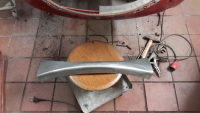
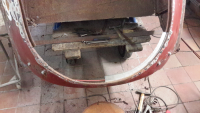 The rear end of the car can be repaired while waiting for the carpenter, and the whole rear lower en of the body is in rather bad condition. Instead of cutting all the bad sheet metal away at once, and then rebuilding, I have chosen to replace one bit at the time to maintain the original shape.
The rear end of the car can be repaired while waiting for the carpenter, and the whole rear lower en of the body is in rather bad condition. Instead of cutting all the bad sheet metal away at once, and then rebuilding, I have chosen to replace one bit at the time to maintain the original shape.
This is very important, because otherwise it becomes very difficult to recreate the original shapes and forms of the original panels.

